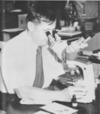 We’ve talked about what to bring, and where to find it. I didn’t mention what we do with it after it gets here, though. There are so many fecal specimens run through our laboratory every day that I just take it for granted. I shouldn’t be doing that, though.
We’ve talked about what to bring, and where to find it. I didn’t mention what we do with it after it gets here, though. There are so many fecal specimens run through our laboratory every day that I just take it for granted. I shouldn’t be doing that, though.
Here’s what happens: about a teaspoonful of poop gets dissolved in a half-ounce of concentrated zinc sulfate solution. This will make the microscopic worm eggs float to the top, just like those people you see bobbing on the surface of the Great Salt Lake or the Dead Sea. Then, the whole mess gets filtered through some gauze into a plastic tube, like those in the foreground. [Yes, that is a messy, nasty job.] The tubes go into the centrifuge, where spinning at high speed puts the heavy poop-stuff down in the bottom of the tube, letting all the cute little eggs float to the top by themselves. Then you look at the top drop under the microscope. All the eggs in the whole sample are in that one little drop, so you should be much more likely to find them than if you just took a smear of poop and looked at that under the microscope.
There are some protozoa (microscopic one-celled animals) that are destroyed by the salts in the flotation process, so we do check a smear under the microscope, too. Overall, though, that’s like checking a handful off a truckload — maybe that truck is full of soybeans, maybe it’s full of motorcycles. You don’t know. That’s why we ask for a bigger sample than the tiny smear.
 This is Dr. Don Schmidt (one of nature’s noblemen), who taught me all of the above about 30 years ago. That’s the way I’ve always done it. The centrifuge in the first picture was purchased in 1979 and the old war-horse is still going (the centrifuge, not me… well, me, too, I guess).
This is Dr. Don Schmidt (one of nature’s noblemen), who taught me all of the above about 30 years ago. That’s the way I’ve always done it. The centrifuge in the first picture was purchased in 1979 and the old war-horse is still going (the centrifuge, not me… well, me, too, I guess).
Imagine my surprise when I attended the gastro-intestinal disease seminar last week and the presenter was selling this as a new idea. He didn’t exactly say it was new; in fact, he said "We’ve known this since the seventies". What was news to me was how few veterinarians have apparently been doing it. You can just look at smears, or you can just let the little eggs float to the top without centrifuging. You miss half of what you’re looking for, but you could do that. Dr. Todd Tams is a GI specialist, and the chief medical officer for the VCA-Antech chain of corporate veterinary hospitals. He made flotation with centrifugation standard practice in the chain just five years ago.
Dr. Schmidt told me what to do, and I’ve been doing it ever since. Unlike some of my other education, which has been superseded by new information, I find I’ve been ahead of the curve by just doing what I learned 30 years ago. How weird is that?


I’ve been taking stool specimens to the vet for 20 years. And never thought to ask what happens to it. Useful info for any pet owners.
I wonder if this is the only such blog post on the Internet.
🙂 See what being in your industry for ages does for you–makes you a trendsetter and you don’t even know it.
Funny how the practical is often dismissed. Now I have some colleagues who are manufacturing products that I have always just told my clients to make themselves.
Perhaps there are some other nuggets of good practical procedures you could share–make a booklet, make a mint.
Kidding aside. I am finding that everything is new again–been around just about as long as you have and I find it amusing.